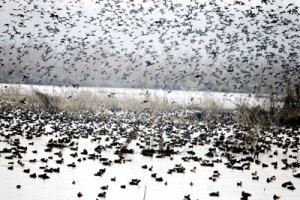Fayaz Bukhari

SRINAGAR Jan 7: Over 5 lakh migratory birds that have arrived in famous Hokersar wetland in the outskirts of Srinagar are facing problems of feeding as the wetland and other water bodies are frozen and Wildlife Department is now feeding these avian visitors.
The cold and dry weather conditions with temperatures plummeting to around minus 6 degree Celsius has led to freezing of the wetlands and other water bodies of Kashmir valley leading to food crisis for the migratory birds.
“There are around 5 lakh birds in the wetland despite subzero temperatures and freezing of the wetland. More will arrive once the temperatures will rise and by February we will be having maximum number of avian visitors”, said Imtiaz Ahmad Lone, Wetland Warden Kashmir.
The Warden said that due to freezing of the water bodies in Kashmir the department is feeding them paddy so as to prevent their starvation. “Our men leave early in the morning and break the ice and spread paddy in the wetland to feed the avian guests”, he added.
Ghulam Hassan, a wild life official, along the other staff start their day early in the morning and leave in boats to break the ice and spread paddy in the water body to feed the migratory birds.
The Hokersar reserve, spread over 7.6 square kilometers, is situated 10 km from City Centre Lal Chowk. The siltation over the years has doomed this wetland and its area is shrinking.
This time there are coots, greylag geese, mallards, teals, shovellers, pintails, gadwalls, wigeons, and purple moorhens in the reserve besides local birds. The cormorants and the sandhill cranes make a brief stopover in the Hokersar wetland and shift to Indian plains during intense cold weather conditions in Kashmir.
These birds come to Kashmir each winter all the way from Siberia, China, Philippines and Turkey and some countries of Eastern Europe.
The wetland reserves were notified as winter homes for migratory birds and declared protected in Kashmir in 1945 by the erstwhile Maharaja, Hari Singh, even though bird shooting as a sport was banned in Jammu and Kashmir only in 1995.
The other bird reserves of Kashmir are Shallabugh, Mirgund and Hygam and these birds also spend the winter months in over 120 other small and big water bodies including Wullar and Dal lakes.
The shooting of migratory birds is prohibited but outside the reserve the poachers shoot these birds. The wild Life department has no sufficient men power to deal with these poachers.

